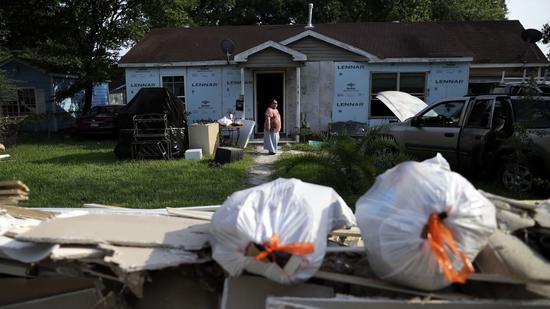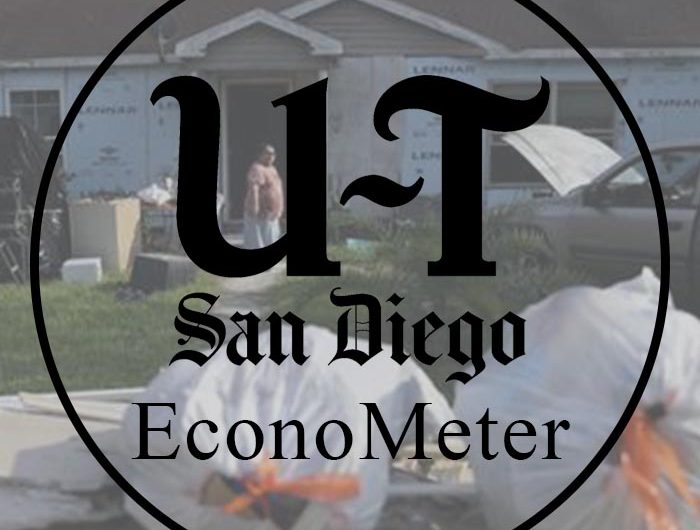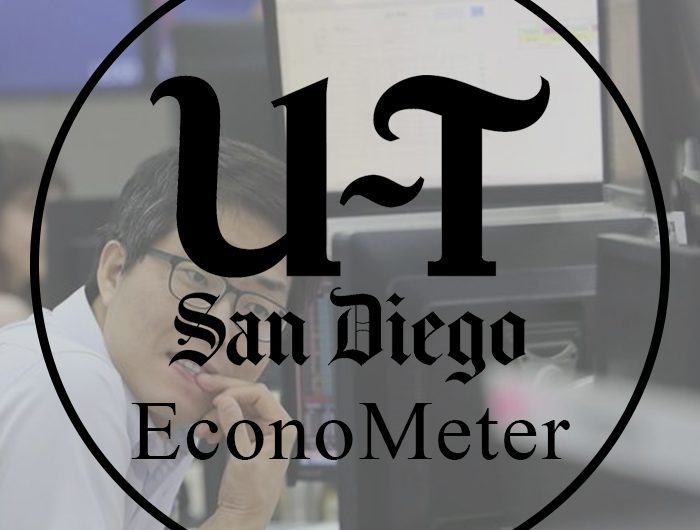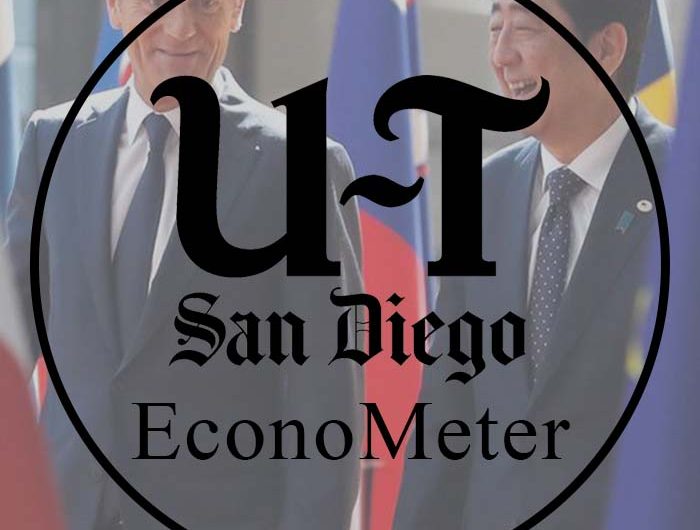Disaster insurance: Should it be mandatory?

By Roger Showley Contact Reporter
Question: Should natural disaster insurance be made mandatory?
Bob’s answer: No
Mandates would prevent incentives to build risk-management processes and are very unpopular. Those in high-risk states must rely on lenders to require borrower insurance.
States must enforce strong building codes and tort reform should be enacted to avoid frivolous lawsuits. Also, Army Corps of Engineers approval should be required to redevelop in disaster-prone areas. Lastly, tax reform should alter GAAP [generally accepted accounting principles] to permit insurance companies to establish reserves for potential catastrophes.
Business Plan Development 2018
Before we complete our business plans for 2018, a review of macroeconomic data is in order. China’s growth might be slowing but we anticipate a fairly steady U.S. economy in 2018. We will likely slow to about a 2 percent GDP growth rate over the next year as this economic recovery reaches the 100 month mark next year.
Unemployment is low, consumer confidence is solid and household spending is strong. Interest rates remain low, business confidence is strong and nothing to derail the economy is imminent. Oil prices have been unusually flat notwithstanding the speed bump caused by Hurricane Harvey.
All of this information bodes well for the hotel market in the U.S. which should lead to our estimate of 3 percent RevPAR growth in 2018. Last year at this time, we projected 4 percent RevPar growth for 2017 and stand by that number. Naturally, the caveat is that unexpected “event” that could stimulate a precipitous decline in demand. We believe that can be averted in 2018 despite the craziness in the Middle East, North Korea’s chest pounding and the turbulent economies abroad.
As we are now nearing the end of summer of 2017, this means budget and market planning time is here.
While many operators merely look at last year’s numbers to budget and forecast, the only meaningful way to budget is to analyze the market thoroughly. Whether you are opening a new business or getting ready for 2018 budgeting, now is the time to begin the planning process.
The following action needs to be taken:
- Review trend report and competitive set information from STR. This will provide a baseline. Ghost call primary and secondary competitors to obtain price points, features and benefits. Obtain sales collateral and start a competitive information file. The process of “elicitation,” coined by John Nolan in “Uncover Your Competitors’ Top Business Secrets Legally and Quickly-And Protect Your Own” discusses the importance of this area.
- Meet with general managers and marketing team members of primary and secondary competitors. Site tour each business and establish a referral program. Coordinate a market review with your franchise marketing manager if appropriate; obtain a franchise national media schedule. Discuss opportunities for digital advertising to promote your business with your extended marketing team. Independents must create a digital presence.
- Develop a 2018 sales and marketing budget; do not assume growth from last year. Review the STR report and other market intelligence and market pace reports carefully. Review quality and quantity of sales collateral and ensure your email lists are updated for newsletters and blasts.
- Review customer information guides whether electronic or printed. Plan a sales blitz. Order blitz giveaways and mementos with your logo, address, web site and phone numbers. Choose items that will stay in contacts office such as candy jars, post-it notes or coffee mugs. Review your central reservation database property information file. Forward to your central reservations database supervisor.
- Meet with key contacts at your Convention and Visitors Bureau and Chambers of Commerce. Obtain a list of advertising and trade show opportunities for budgeting. Contact local Chambers of Commerce and obtain lists of your area’s top businesses and employers.
buy metformin online https://medi-waste.com/wp-content/uploads/2022/08/png/metformin.html no prescription pharmacy
Qualify key companies and individuals to create or update your own emailing or mailing lists/labels. Business Journals also have great lists. Ensure that you have a list of your competitive set top demand generators (360 report).
buy zofran online https://medi-waste.com/wp-content/uploads/2022/08/png/zofran.html no prescription pharmacy - Contact guest loyalty rewards program administrators at franchise headquarters to arrange to promote your business in the next member newsletter. Solicit articles on your business as a feature story. Develop possible press releases for the coming year along with a public relations plan and contact each segment specialist for the franchise worldwide sales staff to see what opportunities are available to promote your business at upcoming trade shows, future segment specific directories or sales missions.
- Create a strong database for electronic mail promotions and ensure your website is not a brochure but rather a focused, customer-acquisition medium. Create website awareness, i.e., create some “buzz” via pay per click, SEO, SEM and unique offerings. And if your website is not mobile optimized by now, this needs to be corrected immediately.
- Continuously create and deliver “can’t-resist” content. Traditional advertising is rapidly losing out as marketing professionals realize the advantages and effectiveness of digital content marketing. Marketing’s new mantra of “brands must now act as publishers” has arrived in part because of social media and its potential to engage in meaningful conversations with their loyal fan base and potential clients alike.
- Develop a permission based electronic marketing program. This is a type of marketing whereby the target audience is solicited by e-mail and his or her approval is sought before marketing to them. By investing in the sharpest media tools like blogs, social media, newsletters, webinars, e-books, photo-sharing, videos, shared media and even Virtual Reality, you will drastically reduce the hefty investments in traditional paid media that are becoming substantially less effective with modern consumers. Simply put, you need to create and share content while being of interest to lots of people to be a player!
- Calculate the lifetime value of a new customer. As an example, if a traveler stays with you two nights per month at $150 per night for 5 years, that is $18,000 in today’s dollars. This data is helpful in determining the value of a new customer. Include calls to action in all advertisements and measure the result of every email marketing blitz and test new approaches periodically.
Use this process now or risk losing your competitive edge! And do yourself a favor and do not create the budget without first reviewing your Business Plan – otherwise you are just entering numbers to make yourself feel good. Remember that all business is local – national trends are merely the foundation of your plan.
Enjoy the end of summer and Q4!
CEOs and White House: An upside to leaving panels?

Question: Is there an upside to business leaders resigning from White House economic panels?
Bob’s Answer: No
NO: There is no upside to business leaders leaving, however, the majority of CEOs and business leaders sitting on the two major, federal panels condemn racism, yet want to keep their seats at the table. All of them state publicly that they are committed to diversity and inclusion, but these companies want to have a voice and provide input on matters that will affect their industry, their companies and their employees in support of growth.
Economic sanctions against North Korea: Will they work?

By Roger Showley
Contact Reporter
Question: Are economic sanctions an effective tool to prevent war with North Korea?
Bob’s Answer: Yes
YES: These harshest-ever new sanctions are a strong first step. China voted for the measure and that is good news.
Now we must cut off access to Chinese and Russian money as well as oil for North Korea’s military.
Further, we must involve South Korea, Japan and China in beginning to denuclearize North Korea by substantially reducing their nuclear capacity and research program—not as we did in Iran with holes in the agreement.
Are America’s tech giants getting too big and powerful?

By Roger Showley Contact Reporter
Question: Are America’s tech giants getting too big and powerful?
Bob’s Answer: No
The U.S. forced Bell Labs to license its patents back in the 1950s, but those times were different as there were clear antitrust issues. The result was great innovation in semiconductors, lasers, cell phones, computer languages and more.
After that, companies like Fairchild, Motorola, Intel, and Texas Instruments helped with the formation of Silicon Valley.
Today, Apple, Microsoft, Google, Facebook and Amazon have more competition. And no, we need not interfere at this time.
Can San Diego County local governments do more to boost housing production, even beyond what San Diego city is contemplating?

Question: Can San Diego County local governments do more to boost housing production, even beyond what San Diego city is contemplating?
Bob’s Answer: No
The slow pace of housing construction has squeezed the market but Mayor Faulconer and our City Council have put forth a bipartisan plan that includes incentives to boost construction of low-income and middle-class housing. Further, the plan is designed to speed up the review process to streamline development, direct funding toward affordable housing and encourage growth in transit-friendly areas.
This is a great start that will stimulate granny flats and other affordable housing.
Summer in the City
Yes, it’s summer but you might be outside a city. Either way, enjoy the remainder of revenues if you are in a strong market or the opportunity to position yourselves for a strong fall season if you are in Phoenix like we are with some of our properties. We are excited about the growth and changes at RAR Hospitality so if we might toot our horn for a short paragraph, we will appreciate it.
First, we are now recognized for our growth in San Diego, Phoenix and finally the U.S. Inc. 5000 will be recognizing us this fall for being one of the fastest growing companies in the country between 2014 and 2016. Recently, in addition to growing to nearly 20 hotel properties, we have added a 30 Under 30 award recipient, Chief Development Officer, Cameron Lamming (also my business partner), a highly talented and acclaimed VP Operations in Janet Fioriti, two rock stars, Director of Accounting Doug Ficke and Marketing Manager Sheryl Paulino and a phenomenal supporting team.
We are poised to handle the changes that are happening in our exciting and noble profession of hospitality. These include but are not limited to Artificial Intelligence and Robotics, OTAs and Airbnb, personalization of vacation experiences, international travel and the ban, information and cyber security, personal training 2.0 and more.
Artificial Intelligence and Robotics
In 1982, Time Magazine declared the personal computer the “Machine of the Year.” Prior to that, Isaac Asimov coined the term “robotics” in 1941, with three easy rules: Robots may not injure humans, must obey orders and must protect their own existence.
I try to avoid negatives but after getting bloodied by unions, robot deniers and even a Chamber of Commerce for employing a robot, I must defend myself. Robots are small, portable, easy to train and reasonably priced. Our robot, acquired from Savioke for our Fairfield Inn & Suites by Marriott in San Marcos, CA, delivers various supplies and products to guests quickly and has tripled our sundry shop sales. Moreover, guests love interfacing with a robot as it is still a novelty. It allows us to let our night auditor stay at the desk rather than abandon the lobby. And perhaps most importantly, “smart machines will replace some jobs, but they will create many more,” according to Jerry Kaplan in last week’s Wall Street Journal article, Don’t Fear the Robots.
OTAs and Airbnb
Online Travel Agencies (OTAs) and Airbnb have awakened today’s hotel community and we are committed to creating loyalty among our guests. The truth is, these companies, who own no real estate yet benefit from our guests, are ahead of us technologically and have come closer to the personalization that we need to provide to keep our guests coming back. And with the growth of travel and tourism, hotels must assume that the competition for our guests will continue. Hence, we need personalization that keeps our guests loyal to us and booking directly with us. According to my colleague and friend Peter Yesawich of MMGY Global, “Guest satisfaction tends to rise with personalization, and service providers enhance their pricing power when they are able to deliver bespoke experiences.” Proudly keep those rates up but do provide very personalized services and embrace technology! If you have not tried Airbnb to see how the communication works, give it a try in the name of awareness—you might see the good and the bad.
International Travel
The international travel market is one that was predicted to fall apart due solely to Donald Trump. Well, I am not here to opine on President Trump, but international travel is up despite the strength of the dollar. Attending a panel discussion at the Arizona Governor’s Office of Tourism Conference in Phoenix last week, I heard from representatives of Germany, China, Canada, United Kingdom, Mexico and France. The panel was moderated by Brand USA executive Mike Fullerton. Mexico’s biggest concern was a laptop ban, Germany was concerned about Trump’s policies, China was fine with our policies and talked about Chinese spending 25 percent of their annual income on travel. France and Canada were also fine with Trump’s policies and the U.K. had their own house to deal with post-Brexit. The travel ban itself did not come up much in conversation. This is clearly a growing market and we must support Brand USA.
Information Security
Information Security is never a fun topic for hoteliers but the Verizon Data Breach Investigations Report (DBIR), Intercontinental Hotels Group Update on Data Breach and other travel industry breaches are becoming more frequent. In the 2017 DBIR, Verizon indicated that over 80 percent of the breaches involved weak, default or stolen passwords. It is critical that we adopt the Secure Payment Solution (SPS) and point to point encryption (P2PE). Ransomware attacks have doubled this year and while I am not assuming that Moore’s Law (every year it will double) is the rule here, be aware that this is serious and that most cyber security and risk experts believe this will worsen.
Personal Training 2.0
As a Faculty Associate at Arizona State University and former corporate hotel training executive, I am very excited about Personal Training 2.0. No, gym workouts are not involved here. This is about taking the manual systems that we used in the past and using a technology solution now. In reading my favorite technology publication, Hospitality Upgrade, I noticed that 93 percent of Millennials say they crave lifelong learning and are willing to spend their own time and money on extended training. 39 percent of Millennials say that they had an opportunity to learn something new that would help them do their jobs better in the last month. Lastly, development opportunities and potential to grow are top factors for them when considering a new job. I am currently exploring these solutions from Amplifire, Axonify, Degreed, Udemy and NovoEd.
Service Animals and Lodging Associations
With the end of summer in sight, I leave you with the Service Animal Dilemma – many of our guests are falsely claiming to have service animals, expecting us to accept “comfort pets” or just plain violating our no pet policies. Just last night, I observed three dogs on a leash barking loudly and being led by a family of four, walking in a back door to our hotel. It is important to know the laws and industry colleague Jim Abrams, California Hotel & Lodging Association has done a superb job of laying out what we can and can’t do. See your hotel association website for details and make sure your guests read their rights—and yours. Speaking of hotel associations, I am an active member of the American Hotel & Lodging Association, California Hotel & Lodging Association and Arizona Hotel & Lodging Association and encourage you to take an active role in supporting this industry.
Have a great August!
Robert A. Rauch, CHA
Bob’s Book Recommendation
 If you need help balancing the stress of work and family, you are not alone! Sheila Henry has wonderful tips and exercises that can help reduce your stress levels in 2 minutes and help you become more focused and productive in your professional and personal life.
If you need help balancing the stress of work and family, you are not alone! Sheila Henry has wonderful tips and exercises that can help reduce your stress levels in 2 minutes and help you become more focused and productive in your professional and personal life.
Professional Mom’s Guide to Success and Sanity: How to Balance Career and Home Life with Less Stress
You don’t have to be a mom to benefit from her teachings.
To learn more about the book and about Sheila click here.
To purchase the book on Amazon click here.
Will trade deal between Japan-EU hurt U.S.?

Question: Will the U.S. suffer economically from the recent trade deal between Japan and European Union?
Bob’s Answer: No
The European Union wanted success before Brexit negotiations and national elections dominate its agenda. This deal is largely about political symbolism.
Average tariffs between the two sides are already low.
Yes, tariffs on Japanese cars will be reduced over the next seven years and tariffs on EU clothing, cheese and more will be reduced but this is not a blockbuster deal that will have material impact on the U.
S.
Mid-Year Report: 2017 Remains Strong
2017 is on pace to be a profitable year but it might spell the end of profitable growth as labor and health care costs are escalating beyond revenue increases. If that occurs, this would be the first year since 2010 where profits did not grow. Our outlook as of mid-year 2017 indicates it will be close but that we will fall short of another year of improved profits.
STR reported a 2016 occupancy of 65.4 percent and it appears that supply and demand are largely in sync, therfore, occupancy levels will hold. Our current outlook is a GDP growth of over 2 percent, maybe even hitting 3 percent later this year and we anticipate this pattern to continue through 2018.
According to CBRE, leisure demand now represents a greater portion of total demand; this has been the primary contributor to the record occupancy levels discussed above. Based on data from STR, weekend hotel occupancies in the U.S. are now almost 10 points higher than weekday levels, and the average daily rates being achieved on Friday and Saturday nights now equal the weekday prices.”
Fitch Ratings expects U.S. lodging RevPAR will decelerate in Q3 and Q4 2017, but remain positive, allowing the strongest and second longest recovery since 1987 to endure through at least 2018. Fitch expects low single-digit RevPAR growth over the next two years, with resort, suburban and airport locations outperforming due to less new supply. We believe that 3 percent RevPar growth is most likely for the next six quarters.
Fitch expects U.S. GDP will grow by 2.1 percent in 2017 and 2.6 percent in 2018. While consumer confidence and employment are both positive, rising interest rates are a concern in their minds. We are not concerned with modest interest rate growth as it will serve to curb new supply growth.
According to Tourism Economics, lodging has outgrown other consumer spend in the last 3 years. We also believe that this will continue through 2018. Despite the above concerns from Fitch, interest rates are low, the recovery from 2010-2016 was not particularly robust, tax reform and repatriation of funds remains available to us, debt and equity both remain available. The 1990s brought us 111 straight months of growth. We believe we can attain that again.
Foreign capital, frequently from China, continues to keep values steady if not higher than last year. Mergers and acquisitions are creating savings but when it comes to individual assets, the time has come to really optimize asset value in preparation for a change in the economy down the road.
STR has identified a tipping point where negative revenue per available room (RevPar) growth in a certain number of U.S. submarkets indicates a turn in national RevPar performance. Naturally, there are cities where it is clear that external events produced negative RevPar growth. Those of us in Southern California know that Los Angeles received massive demand last year from the Porter Ranch gas leak. This has impacted year over year performance in 2017.
New York has been hit with extremely high, double-digit supply growth and San Francisco has a closed Moscone Center. Double-digit supply growth will also impact Denver, Seattle and Nashville but forecasts for 2017 and 2018 call for flat occupancy levels and average rates at or above inflation.
Other Tipping Points
In the area of wages vs. robotics, we may be entering an era of profound artificial intelligence use in the hospitality industry. We have added a service robot at our Fairfield Inn & Suites in San Marcos, California and others will soon add housekeeping robots to vacuum, thereby reducing room cleaner times and helping reduce the troublesome back injuries our team members have. Wage growth is off the charts thanks to legislation mandating minimum wage increases of nearly 90 percent over a 7-year period from $8-$15 in California, a compound annual average increase of nearly 13 percent.
There is also a tipping point that we are reaching from OTAs vs. hotels where hotels are fighting to increase direct bookings and OTAs continue to promote and advertise aggressively. AH&LA has a comprehensive plan to combat this but coexistence is still possible!
Lastly, the supply/demand ratio is at a tipping point where supply is beginning to outpace demand and the millennials/boomers ratio is also at a tipping point where millennials will begin outpacing boomers in hotel demand. And yes, Airbnb is certainly reducing both the occupancy levels and average rates of high demand periods that previously showed strong compression from the market. Enjoy the summer ride, it will still be loads of fun!














